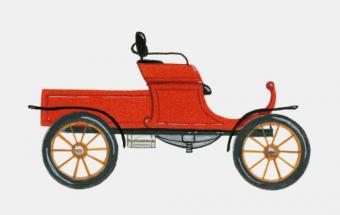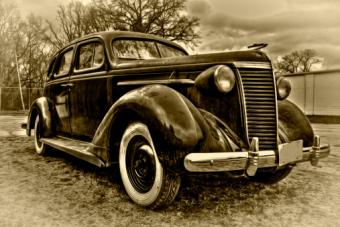
Old automobiles have two main classifications, antique and classic cars. According to the Antique Automobile Club of America (AACA), antique cars are more than 45 years old, while classic cars are at least 25 years old. These can also be broken down into other categories and subdivisions.
Categories of Antique and Vintage Cars
Antique and vintage cars can be categorized according to the era in which they were manufactured, although the classifications are every changing notes the AACA. Although numerous steam-powered vehicles were invented over the centuries, German engineer Carl Benz is considered the inventor of the first modern gasoline-powered automobile, according to the Automotive Hall of Fame. He founded Benz & Cie, which became the world's largest manufacturer of automobiles in 1900 and is now known as Mercedes Benz.
The Veteran Era

The Veteran Era (1888 to 1905) introduced the first successfully manufactured autos. During this period, History.com notes that autos were individually constructed, a slow process that resulted in extra expense and forced consumers to wait months for them to be finished. Early autos were powered by steam, electricity, or gasoline, although cars with internal combustion engines were faster and could travel longer distances. These cars broke down often, both from mechanical woes and because dirt roads were too pitted and rutted for horseless carriages. Fuel was hard to find and with the quickly changing technology, car owners discovered that their beloved vehicles were soon obsolete. Because of these issues, automobiles were more of a hobby than a practical mode of travel.
Popular Veteran Era autos and their original prices include:
- 1903 Winton touring car: $2,500
- 1904 curved-dash Oldsmobile: $650 per History.com
- 1905 Ford Model F: $1,200
Current values for Veteran Era autos:
- 1903 Oldsmobile Model R 'Curved Dash' Runabout: $58,608, sold via Bonhams
- 1904 Ford Model 'AC' Tonneau: $88,000 sold via Bonhams
The Brass Era
The Brass Era (1905 to the start of World War I in 1914) took its name from the brass decorations from lights to radiators found on these early cars.

In 1908, Henry Ford produced the Model T, an inexpensive car with standardized parts. Model Ts were extremely popular and ushered in the "everyman's" automobile. Faced with the demand for cars exceeding supply, Ford developed an improved auto assembly line in 1913 that reduced building a chassis from 12.5 to 1.5 hours and eventually enabled the company to deliver 100 Model Ts per day, according to the Ford Motor Company. Mass production changed manufacturing, making the job faster and offering components that could be swapped from one car to the next with the perfect fit. Ford's Tin Lizzie is well-known, but there were many other car makers at this time; there were hundreds of manufacturers in the United States before the Depression. Developments included electronic ignition systems, four-wheel brakes, leaf springs for suspensions, and the shift from wooden bodies to steel bodies with wood structures.
Important Brass Era cars include:
- 1906 Ford Model N: $600 per History.com
- 1908 Fritchle Model A electric roadster: $2,000
- 1910 Thomas 'Flyabout' roadster: $6,000
Current values for Brass Era automobiles:
- 1906 Winton Model K Touring: $160,000 sold via RM Sotheby's
- 1906 Ford Model N: $12,650, sold via RM Sotheby's
- 1910 Thomas Flyer Model K 'Flyabout': $825,000, sold through Bonhams
- 1912 Oakland Model 40 Touring: $28,265, sold through Bonhams
Vintage Era
The Vintage Era (1918-1929) encompassed the decade between the end of World War I and the stock market crash that ignited the Great Depression. Cars included enclosed areas for passengers and comfort was more of a consideration. Increasingly powerful engines with eight, 12, and even 16 cylinders were finding favor over the slower, vibrating 4-cylinder engines found in many brass-era cars.

By 1925, there was one automobile for every six persons in the United States, according to a report from the Library of Congress. Five years later, in 1930, that amount had changed to one car for every 4.6 people in the nation.
Important cars of this period were:
- Ford Model T: Prices in 1909 started at over $800, but by 1925 were reduced to $290
- 1924 Chevrolet touring car: $525 per ads at The People's History (TPH)
- 1923 Maxwell sedan: $1,045 via TPH
- 1921 Cadillac touring car: $3,940 according to TPH
Current values of Vintage Era autos include:
- 1924 Chevrolet Superior F Touring: $25,850, sold through Barrett-Jackson
- 1922 Cadillac Model 61 Touring: $19,800, sold by Bonhams
- 1923 Maxwell 25 Club Coupe: $10,500, sold through Mecum

In 1930, several automakers consolidated or went out of business, leaving just a few major car manufacturers, many of which are still in business today. General Motors consolidated Chevrolet manufacturing with Pontiac and Buick with Oldsmobile. In 1933, in the throes of a devastating economy, GM managed to sell 753,039 new vehicles in the U.S., according to Automotive News.
Significant cars of this era include:
- 1929 Studebaker President roadster: $1,895 per TPH ads
- 1938 Hudson 112 sedan: $694
- 1948 Cadillac Series 61 sedan: $2,833
Current values of Pre-World War II Era autos:
- 1927 Studebaker Erskine SIX: $16,500, sold by Dorotheum
- 1937 Hudson Terraplane: $40,700, sold through RM Sotheby's
- 1948 Cadillac Series 62 Cabriolet by Saoutchik: $857,500, sold by RM Sotheby's
Post War Era
In 1949, General Motors introduced the high-compression V8 engine in its Oldsmobile and Cadillac brands, setting the stage for affordable larger, more powerful cars. Cars became more flamboyantly styled, and the demand rose among the middle-class families headed by returning troops from the war.

By 1960, American auto manufacturers worried about foreign competition as Japan and Europe perfected smaller, more fuel-efficient cars. They countered with Chevrolet's rear-engine Corvair, Ford with the Falcon, and Chrysler with the Valiant and Lancer; all introduced in 1960. With the introduction of Ford's sporty Mustang at the World's Fair in New York in 1964, a wave of more performance-oriented cars was about to sway drivers away from the "compact" cars of the early 1960s. This created a sub-category known as Muscle Cars.
Important cars of this era include:
- 1955 Chevrolet Nomad station wagon: $2,571
- 1964 Ford Mustang: $2,368
- 1972 Chevrolet Corvette sport coupe: $5,472
Current values of Post War Era autos include:
- 1955 Chevrolet Bel Air 210: $52,000, sold through Gateway Classic Cars
- 1965 Ford Mustang Fastback Coupe: $43,093, sold via Bonhams
- 1969 Chevrolet Corvette Stingray: $38,000, sold by GAA Classic Cars
How Are Antique Cars Appraised?
If you plan to drive your restored automobile, it will need to be insured by a company that specializes in classic and/or vintage cars. Hagerty Insurance features a handy online valuation tool for cars made since 1945. You will need to create an account to access the site's features. Most antique cars fall into one of six categories. Ultimately, car value is determined by the desirability, rarity, condition, and quality of the restoration.
- Parts car: This is a car that has no value except for the individual vintage parts that can be used in restoring other cars.
- Restorable: This is a deteriorated car that can be restored.
- Good: A good car is one that needs only minimal rebuilding. If it has a low-quality restoration, the value will not increase even if it is in good running condition.
- Very Good: This car is running and the restoration is acceptable or it is in good original condition.
- Fine: A carefully restored car with mostly original or reproduction components that is in good working order.
- Excellent: An antique car that has been perfectly restored or one that is in mint original condition.
Enjoying Antique and Vintage Cars
While most people can't afford a collection of antique and vintage cars, it is fun to look at them at antique auto shows and in museums throughout the U.S. Automobiles are a beautiful piece of history, showing the ingenuity, design, and craftsmanship exhibited throughout the 20th century. They are a reminder of a time when the ability to get from one place to another was not taken for granted and a car trip-short or long-could also be a special, unique experience.







